Using FMEA Knowledge Banks
FMEA Knowledge Banks allows you to create data banks of all your FMEA information. You can then retrieve that data and automatically insert it into your FMEAs. Your FMEA Knowledge Banks grow over time and becomes an efficient and powerful way to reuse and reapply lessons learned from one FMEA to the next, or to maintain consistency across FMEAs.
You can have a single Knowledge Bank, or multiple Knowledge Banks. If you have only one Knowledge Bank, Relyence automatically saves and retrieves data from that Knowledge Bank. If you have more than one Knowledge Bank, you will be asked to select which Knowledge Bank to use when storing FMEA information.
Relyence will automatically create the first Knowledge Bank for you with the name Knowledge Bank 1. To rename this Knowledge Bank, click Bank Properties from the Sidebar menu when the Knowledge Bank is open. You can rename and create additional Knowledge Banks using the Manage Analyses function.
Opening a Knowledge Bank
To open a Knowledge Bank, click Knowledge Bank(s) in the Sidebar menu. If only one Knowledge Bank is in use, the Knowledge Bank will be opened.
If multiple Knowledge Banks are in use, the last five most recently used (MRU) Knowledge Banks will appear in the Knowledge Banks submenu. If the name of the Knowledge Bank appears in the MRU list, click the name to open it. If the name of the Knowledge Bank does not appear, click More... from the submenu.
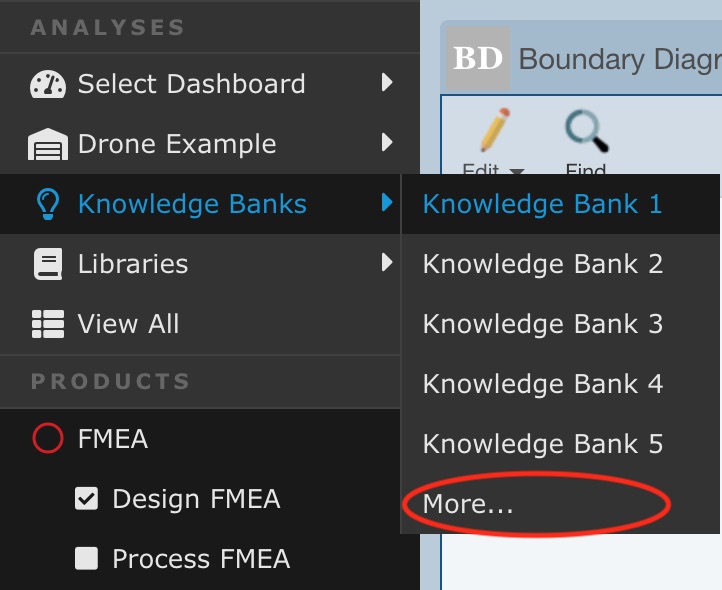
The Knowledge Banks dialog appears.
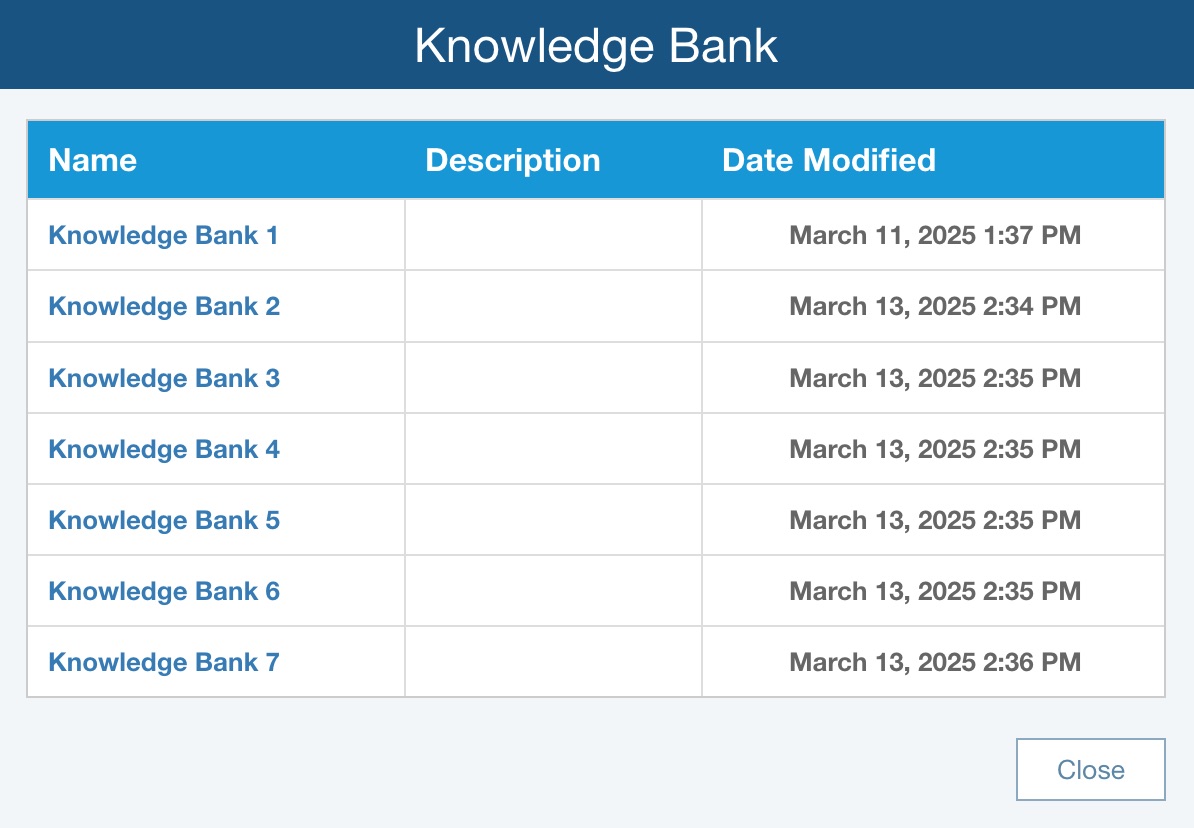
Click the name of the Knowledge Bank to open it.
Knowledge Bank Properties
You can rename a Knowledge Bank, add or modify a Knowledge Bank description, or set the Audit Log option by accessing the Properties of a Knowledge Bank.
Open the Knowledge Bank you wish to update, and click Bank Properties from the Sidebar menu.
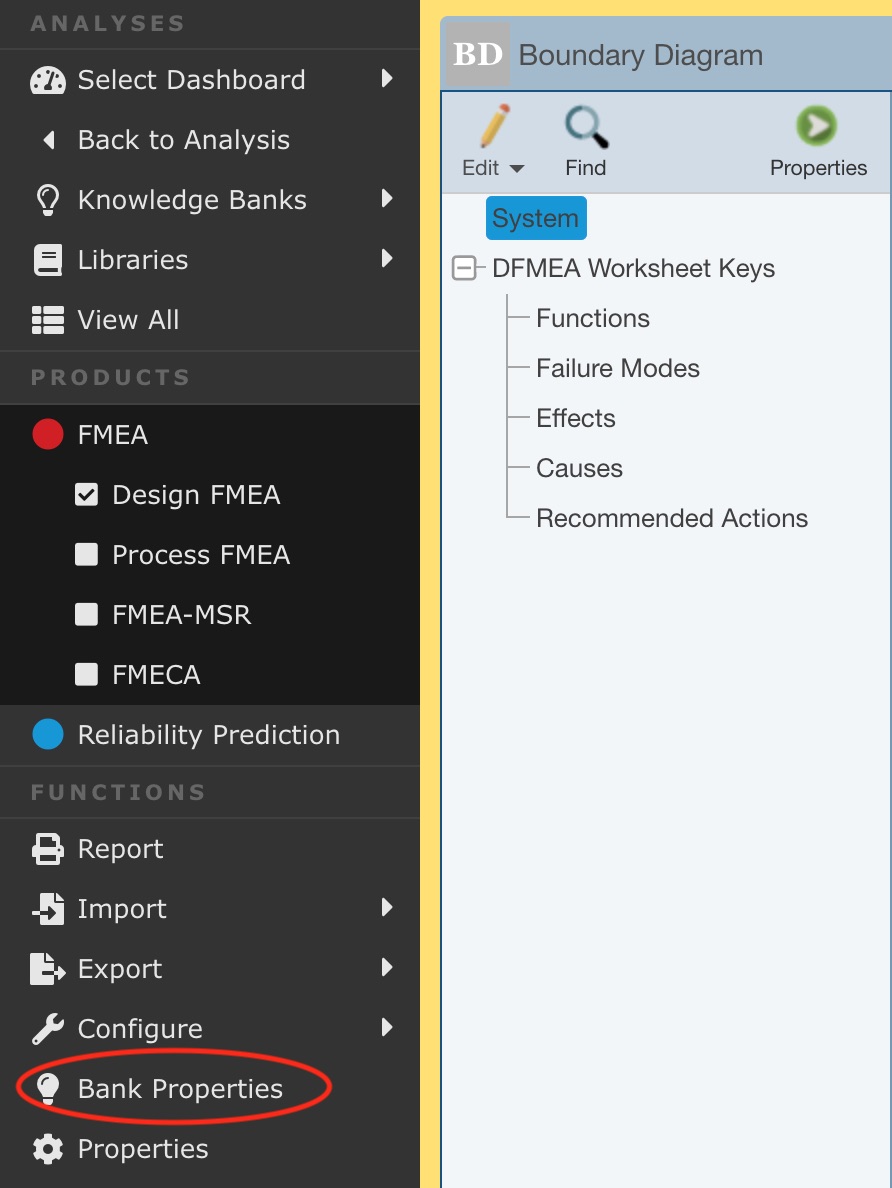
The Knowledge Bank Properties dialog appears.
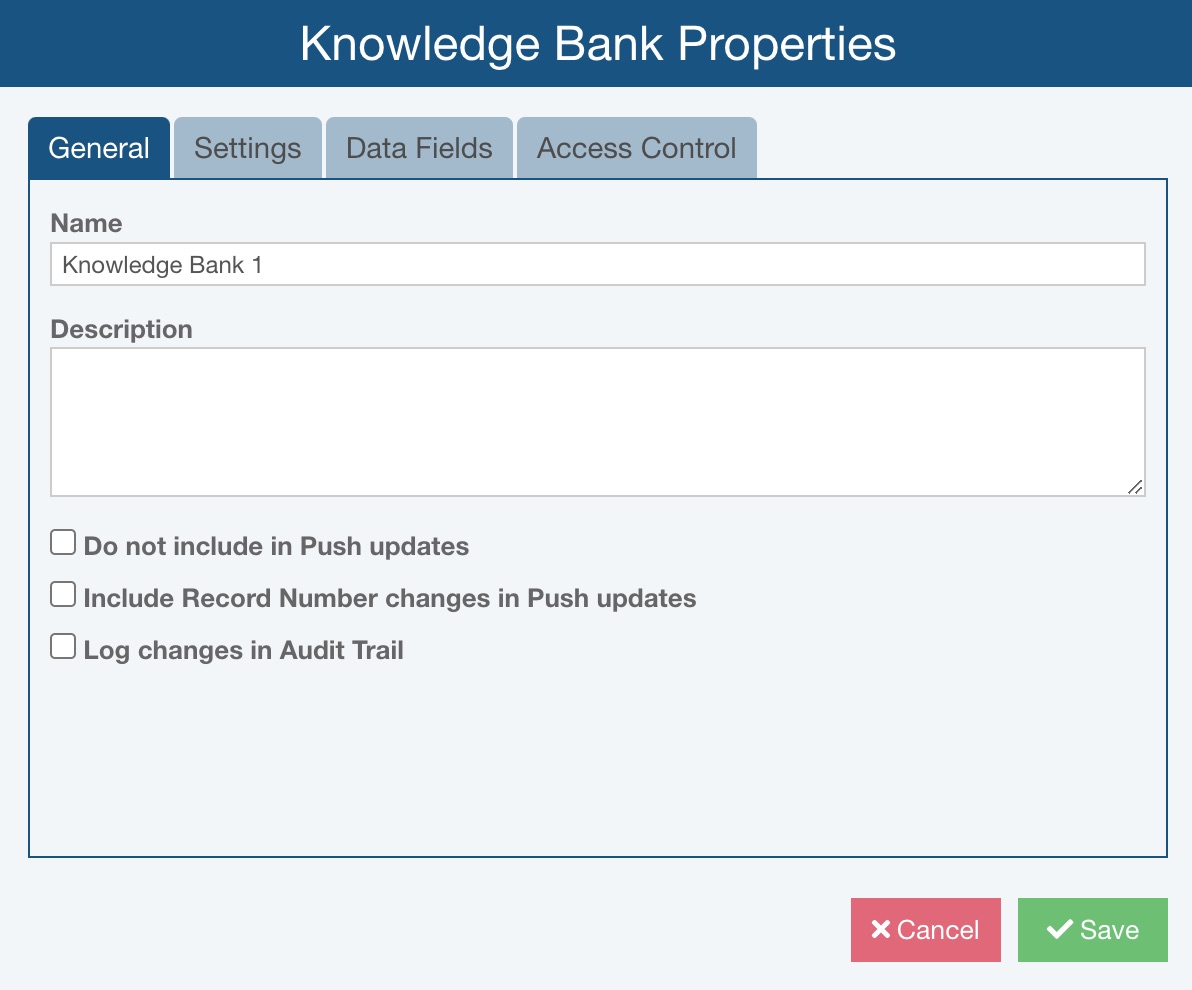
On the General tab, you can enter basic Knowledge Bank properties.
Edit the Name for your Knowledge Bank, if needed. Knowledge Bank names must be unique.
Enter a Description, if desired.
Check Do not include in Push updates if you do not want any changes from the Knowledge Bank(s) to propagate to this Knowledge Bank.
Check Include Record Number changes in Push updates if Record Number changes should be included in Push updates. Note that if Record Number changes are pushed, then records in the Knowledge Bank are moved to new locations based on Record Number. This option is cleared by default.
If you are licensed for the Audit Trail capability, use the Log changes in Audit Trail checkbox to enable or disable audit tracking for the Knowledge Bank.
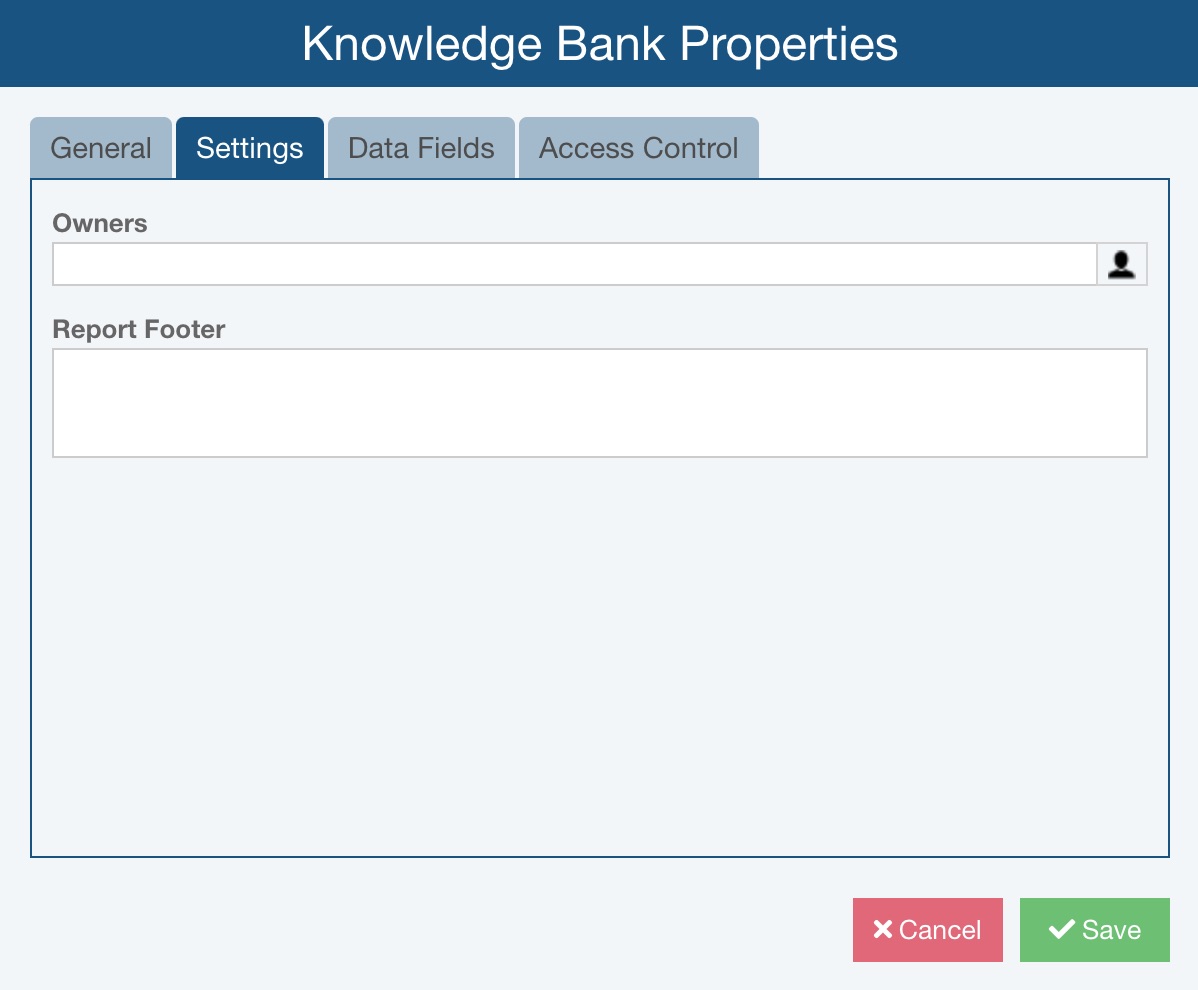
On the Settings tab, you can enter additional basic Knowledge Bank properties.
For Owners, select from the list of team members to identify the Owners of this Knowledge Bank, if desired. Click the Team Member selector button to bring up the Team Members dialog and select the appropriate names from the team member list.
For Report Footer, enter the preferred text for any report footer that should be included on Reports of data in this Knowledge Bank; it will be centered in the footer.
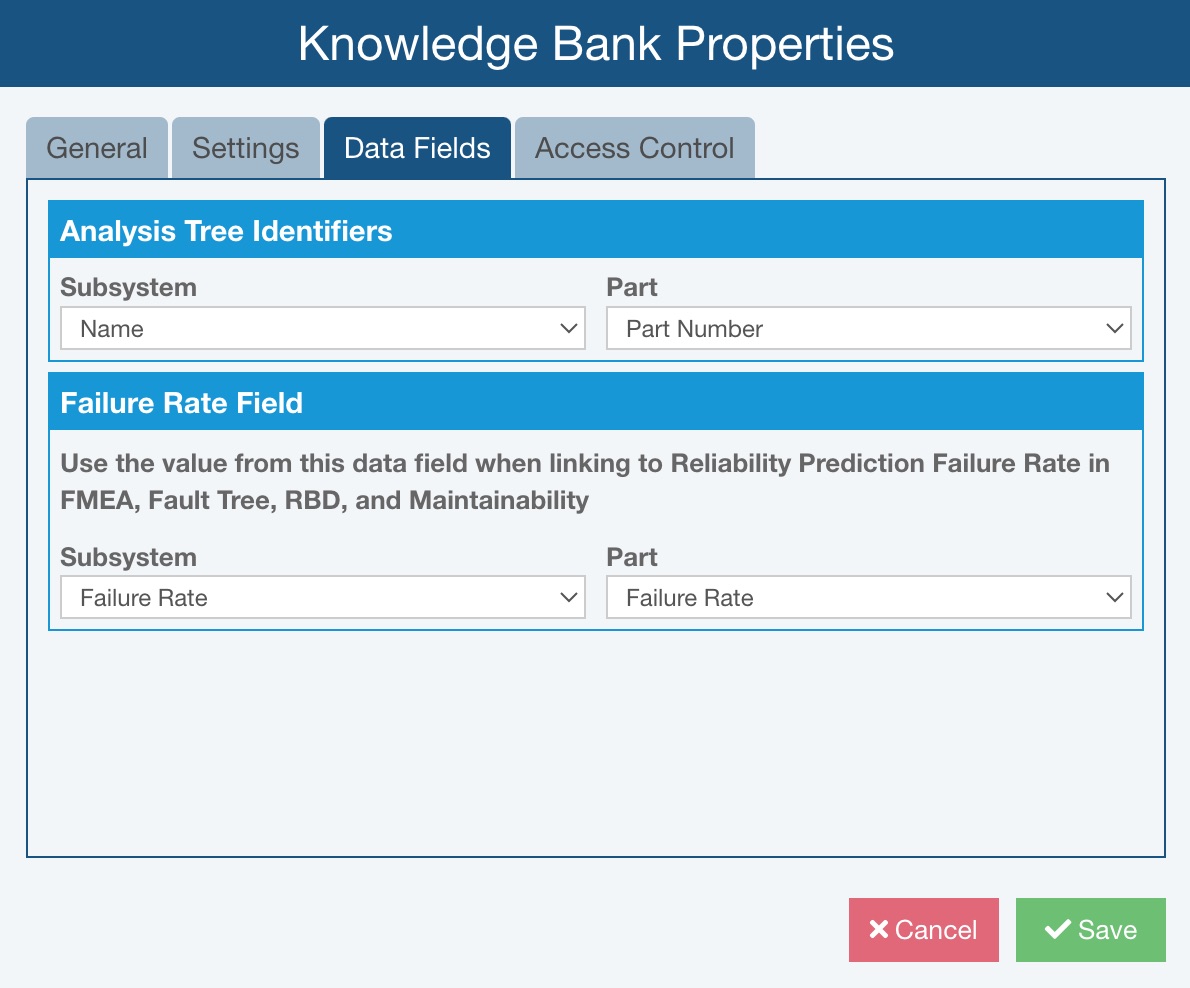
On the Data Fields tab, you can specify Analysis Tree Identifiers and Failure Rate Field details.
Set Subsystem and Part details in the Analysis Tree Identifiers section. By default, in the Analysis Tree, Relyence shows the Name field for Subsystems and the Part Number field for Parts. If desired, you can select an alternate display field for Subsystems and Parts. If you do choose another display field, the selected field will appear in any place where the Name or Part Number was shown for Subsystems and Parts, respectively.
Set Subsystem and Part details in the Failure Rate Field section.
Note: These property settings only appear if the Knowledge Bank includes Reliability Prediction.
By default, the Failure Rate field is used for items in FMEA, Fault Tree, RBD and Maintainability that are linked to Reliability Prediction Subsystems or Parts. If you would prefer to link to a data field other than the Failure Rate, you can select it here for both Subsystems and Parts using the Subsystem and Part dropdown lists.
Regardless of which field you choose to link to, note that Relyence assumes its units to be the same as the Failure Rate field, which is set via the Failure Rate Units on the Settings from the Account menu. For example, for Parts, if you choose to link to the User Value 1 field, and your Failure Rate Units value is Failures/Million Hours, be certain that your entered or calculated value is in units of Failures/Million Hours.
A special Relyence field, My Reliability Prediction Failure Rate, can be added to applicable Analysis Tree Properties panes, the Parts Table, and the FMECA Worksheet to verify the Failure Rate value that will be used when linking a subsystem or part to FMEA, Fault Tree, RBD or Maintainability data.
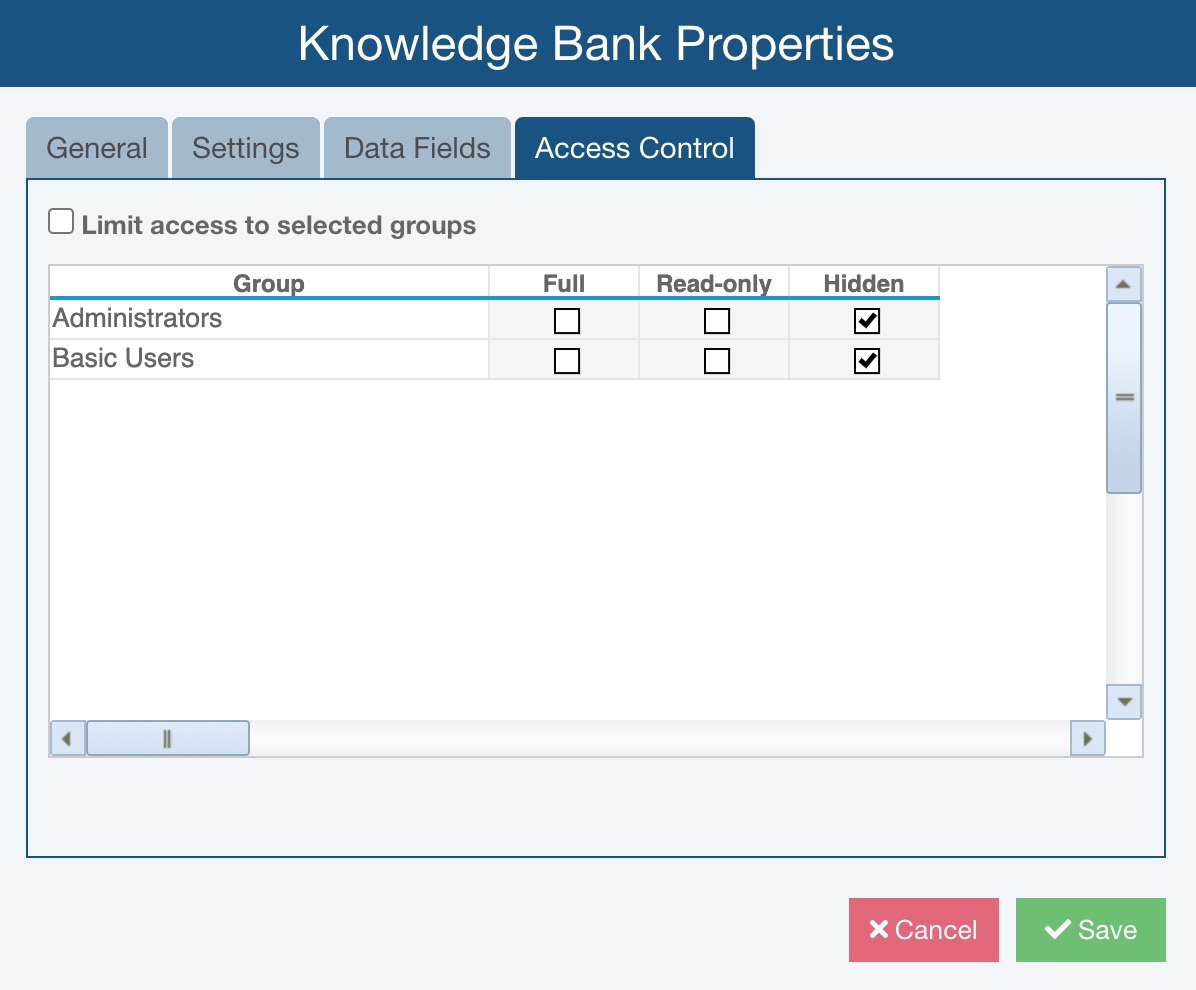
On the Access Control tab, you can enter details to control access to the Knowledge Bank access on a Group basis.
Check Limit access to selected groups for your Knowledge Bank if you want to grant/deny access to the Knowledge Bank by Group. You can select Full, Read-only, or Hidden access for each group by selecting the appropriate checkbox. Full access gives permissions to open and edit the Knowledge Bank. Read-only access gives permissions to view, but not edit the Knowledge Bank. Hidden access means Users in that group will not see the Knowledge Bank.
Click Save when you are complete.
Adding FMEA data directly to a Knowledge Bank
You can directly access a FMEA Knowledge Bank by clicking Knowledge Bank(s) from the Sidebar menu.
If you are accessing the Knowledge Bank feature for the first time, a Knowledge Bank named Knowledge Bank 1 will be automatically created for you.
If only one Knowledge Bank is in use, it will be opened. If more than one Knowledge Bank is in use, select the Knowledge Bank to open from the submenu.
The FMEA Knowledge Bank interface operates in the same manner as the FMEA interface, so the features and functions are the same. Notice that the background when you are in a Knowledge Bank is yellow to make it easy to distinguish from your FMEA, which has a blue background.
The Tree pane in a Knowledge Bank varies from the FMEA Tree pane. It also includes FMEA line item data such as Functions, Failure Modes, Effects, and Causes.
You can directly add FMEA data to a Knowledge Bank by using the Knowledge Bank interface if you desire.
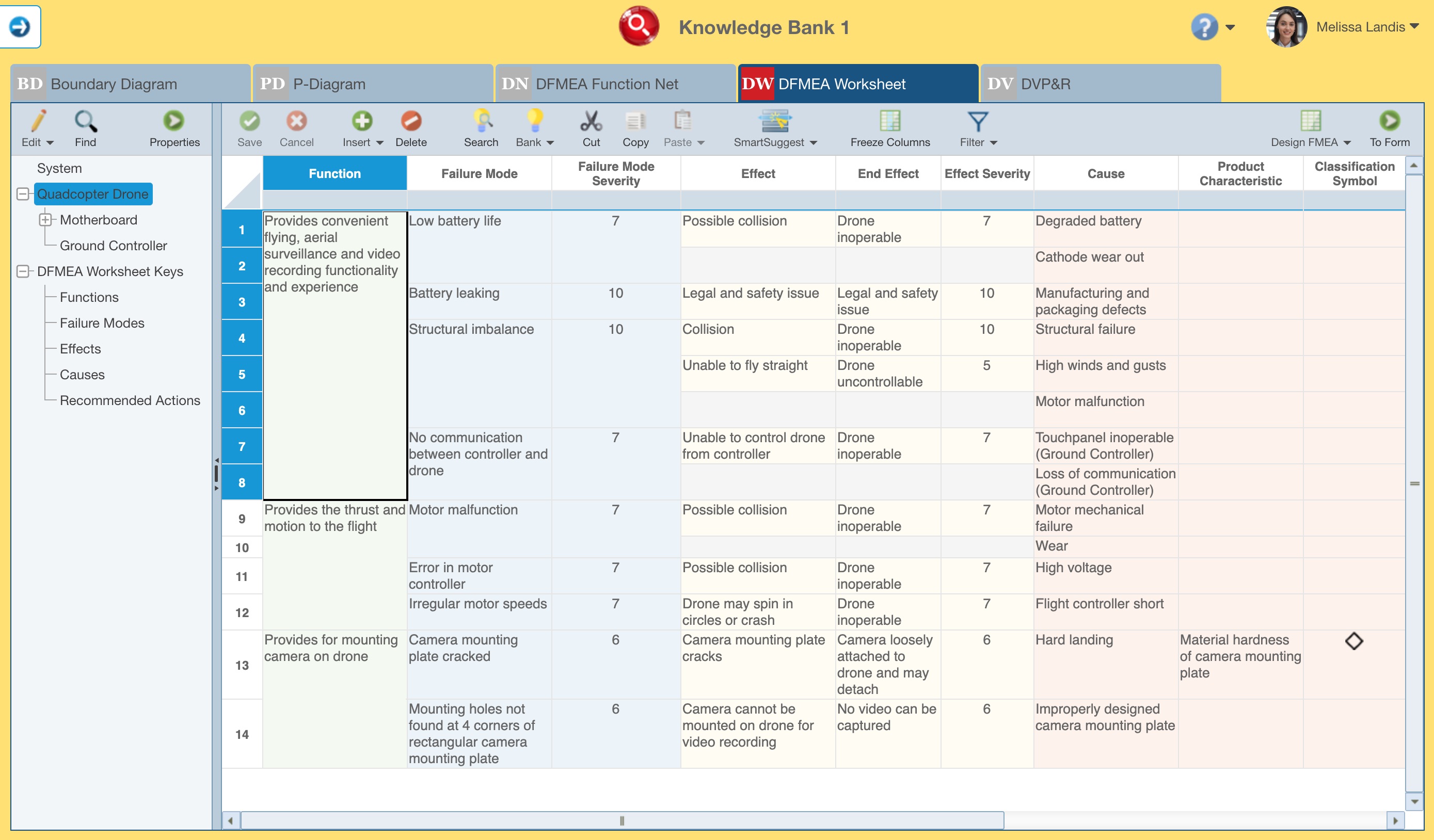
This includes adding data in the Analysis Tree or on any of the FMEA tabs such as the DFMEA Worksheet.
You can also add data to a Knowledge Bank from another Knowledge Bank using the Search button.
You can tie data from a Knowledge Bank to data in Analyses or data in other Knowledge Banks.
In the case of using data from one Knowledge Bank within another Knowledge Bank, you can ultimately create a hierarchy of Knowledge Banks, if needed.
For example, one Knowledge Bank could store all Failure Modes and related mode data that you want to reuse. Then, another Knowledge Bank could store all Functions or Process Steps and related data, including Failure Modes from the first Knowledge Bank. Finally, a third Knowledge Bank could store Subsystems to represent subsystems or processes that store data including Functions or Process Steps from the second Knowledge Bank, which stores Failure Mode data from the first Knowledge Bank.
Note that for DFMEA and FMECA data, you can include data for Parts if you select Perform Piece-Part Analysis on the FMEA Properties, including data from the FMD Library (Using the FMD Library) and the custom Part Failure Modes Library (Using the Custom FMEA Mode Library).
Click Back to Analysis in the Sidebar menu to return to your Analysis.
Building up Knowledge Banks from your FMEAs
The most common method of building up your FMEA Knowledge Banks is adding information from a completed FMEA to it.
You can add any level of FMEA data to your Knowledge Banks - Analysis Tree items, Functions, Modes, Effects, etc. Any FMEA items you add to a Knowledge Bank includes all the information associated with it. For example, if you add a Failure Mode to a Knowledge Bank, the Effects and Causes and all other data is added along with the Failure Mode. Or, if you add an Analysis Tree item to a Knowledge Bank, all of its FMEA data including any Boundary Diagrams and P-Diagrams will be included in the Knowledge Bank. Anytime you reuse this Failure Mode in a FMEA, all the data will be automatically retrieved.
To add FMEA data to a Knowledge Bank, select the item you wish to add, and click Add to Knowledge Bank from the Bank toolbar button drop down.

In addition to adding specific FMEA data via the Add to Knowledge Bank function as above, you can also add subsystems and all related data using the Add to Knowledge Bank option from the Analysis Tree Properties as shown below.
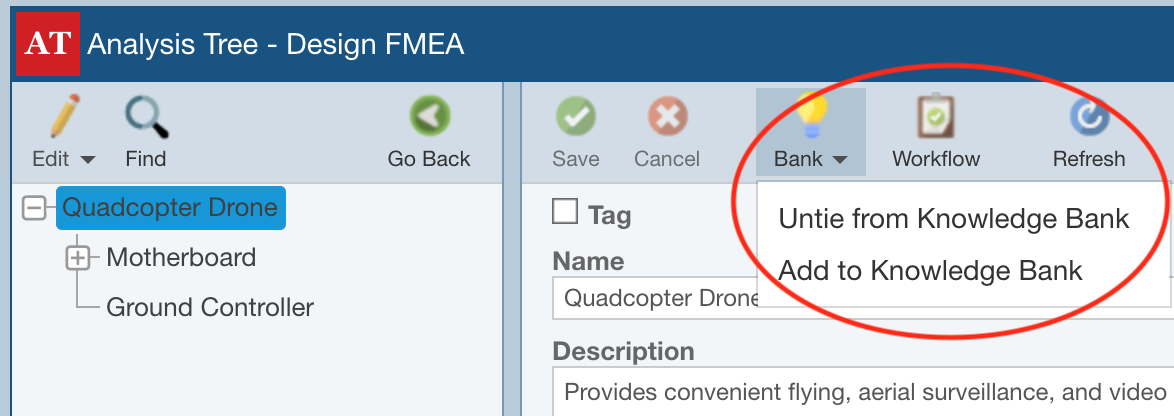
If one Knowledge Bank is in use, you will be asked to verify that you wish to add the data to the Knowledge Bank, click Yes. If no Knowledge Banks have yet been created, an initial Knowledge Bank named Knowledge Bank 1 will automatically be created and the selected data added to it. (Note that you can rename Knowledge Banks using Bank Properties and manage your Knowledge Banks using the Manage Analyses function.) The Add to Knowledge Bank dialog appears once the data the Knowledge Bank has been updated. Click Close to dismiss the confirmation dialog.
If you are using more than one Knowledge Bank, the Knowledge Banks dialog appears.
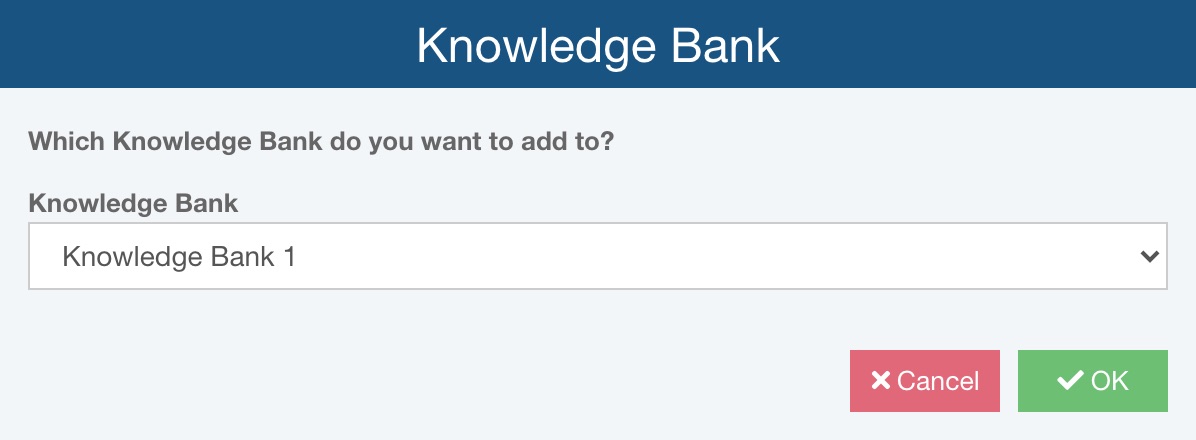
Select the Knowledge Bank you want to add to and click OK. The Add to Knowledge Bank dialog appears to ask you to confirm; click Yes. The Add to Knowledge Bank dialog appears once the data the Knowledge Bank has been updated. Click Close to dismiss the confirmation dialog.
You can also add Analysis Tree items to a Knowledge Bank. Click on the Analysis Tree item you wish to add, then click the Properties button in the Analysis Tree pane toolbar to view the Tree item properties. Click Add to Knowledge Bank from the Bank toolbar button drop down in the Properties pane. If using more than one Knowledge Bank, select the Knowledge Bank to use. The Analysis Tree item and all the FMEA data associated with it will be added to the Knowledge Bank.
Note that you can rename Knowledge Banks using Bank Properties and manage your Knowledge Banks using the Manage Analyses function.
Using Knowledge Banks when performing FMEAs
The power of Knowledge Banks becomes apparent when you utilize them when performing your FMEAs. As you are working on your FMEA, you can search the Knowledge Banks using the built-in search capabilities to locate information stored in them and bring it into your current FMEA. As your Knowledge Banks grow, the effort required to build your FMEAs is significantly reduced.
To search Knowledge Banks while in your FMEA, go to the FMEA level you want to search on. For example, to search for Failure Modes, make sure a Failure Mode cell is selected in your FMEA Worksheet. The search feature recognizes the data level you are on and searches for the appropriate data. Click the Search button in the FMEA toolbar.

The Search dialog appears. The contents of the Search dialog will be based on the active data field in your FMEA Worksheet. The screenshot below appears when the Search button is clicked when on the Failure Mode field in the FMEA Worksheet. (Note: The Knowledge Bank column does not appear if you only one Knowledge Bank is being used.)
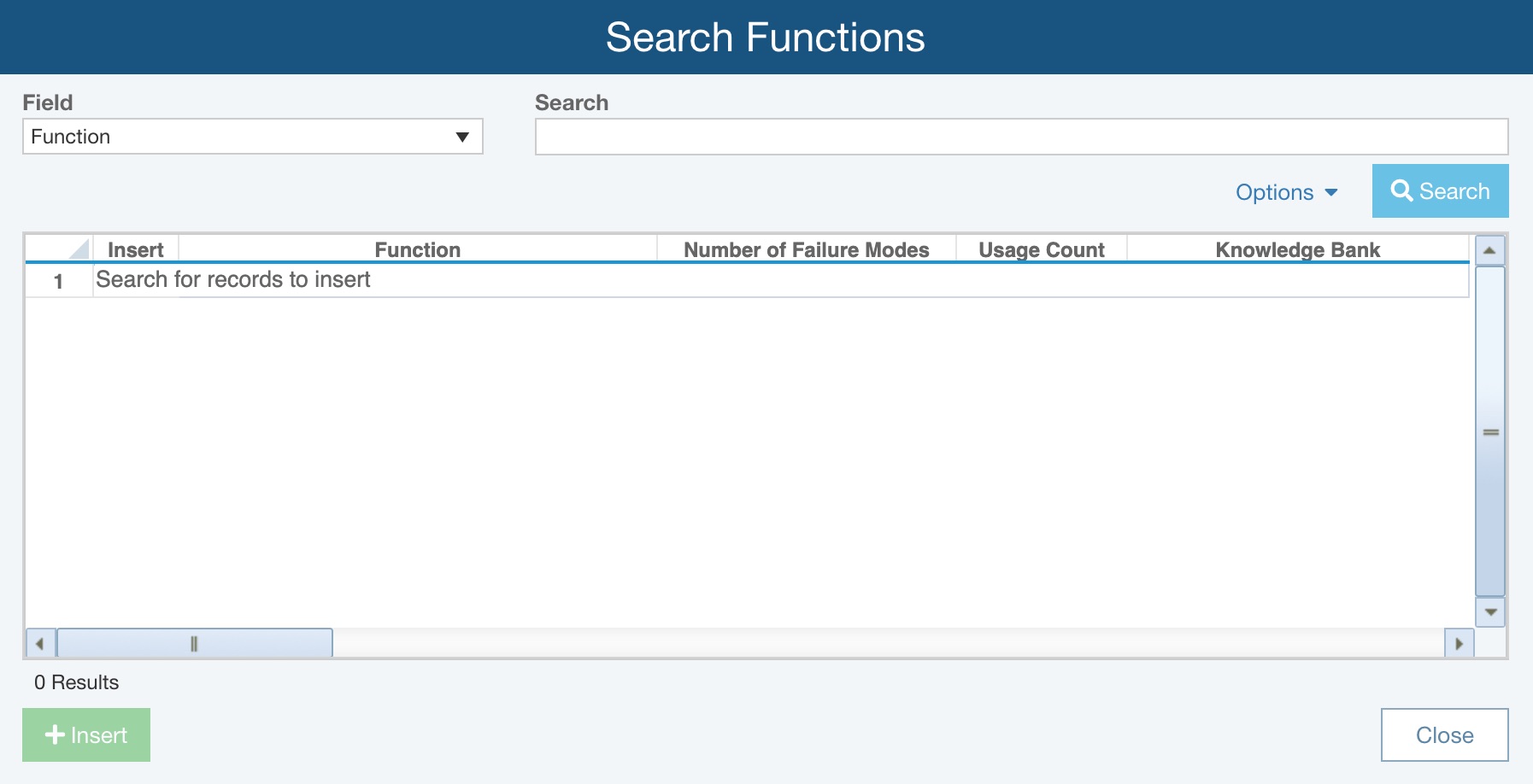
Field is used to indicate which data field is to be searched for the text entered in Search and is set by default to the active field on your FMEA Worksheet (i.e. the field you are on when you click Search). You can perform a Knowledge Bank search on any of the text-based field associated with the FMEA level you are on. For example, in the screenshot above, the Search button was clicked when on the Failure Mode field in the FMEA Worksheet. In this case, there is only one field available - the Failure Mode field itself, so Failure Mode is selected in as the Field.
As needed, use the Options link to establish your preferred search and sorting options.
For Show, choose between:
- All Results - returns all results that match search criteria
- Results not used in this Analysis - returns all results that match search criteria and are not yet used in the current Analysis/Knowledge Bank (this could help identify if some records from the Knowledge Bank, such as Requirements for DVP&R, are not yet used in an Analysis)
Use the Sort By options to select your preferred sort order:
- -- No Sort --
- Usage Count
- Alphabetically (choose the available field, such as Function)
In the example below, the Search button was clicked when the Recommended Action field was active. Field is set by default to Recommended Action. However, you can click the dropdown list and select from other text fields at the Action level to search: Actions Taken and Responsibility.
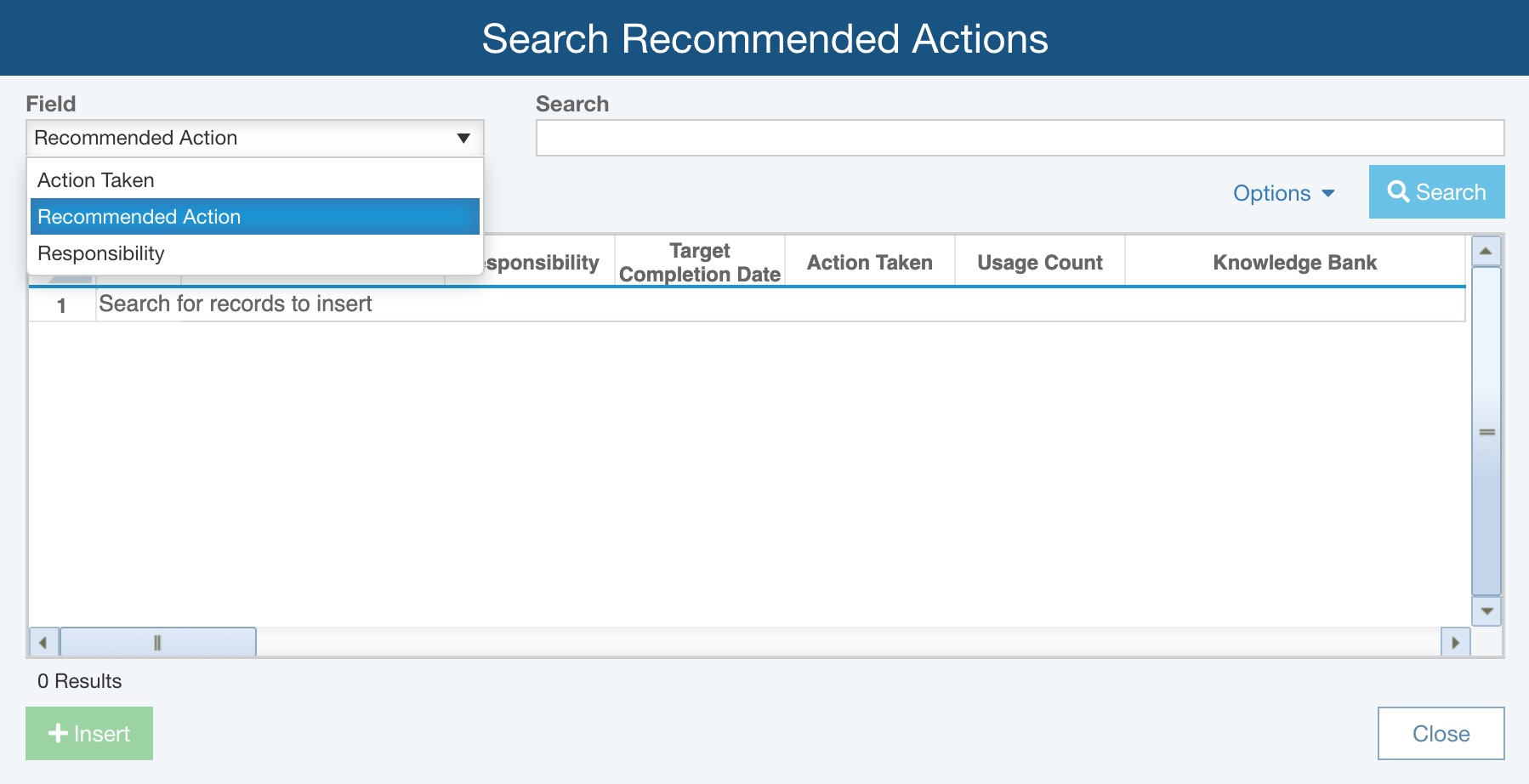
In the Search dialog, enter in a portion of the text, or the full text, in the Search field. Click the Search button to start the Knowledge Bank search. The list of matches will appear in the table. The search results table includes other information: other related FMEA data, the usage count (the number of times the particular item is used in your FMEAs), and which Knowledge Bank the match is from. The table is sorted by Usage Count in descending order by default.
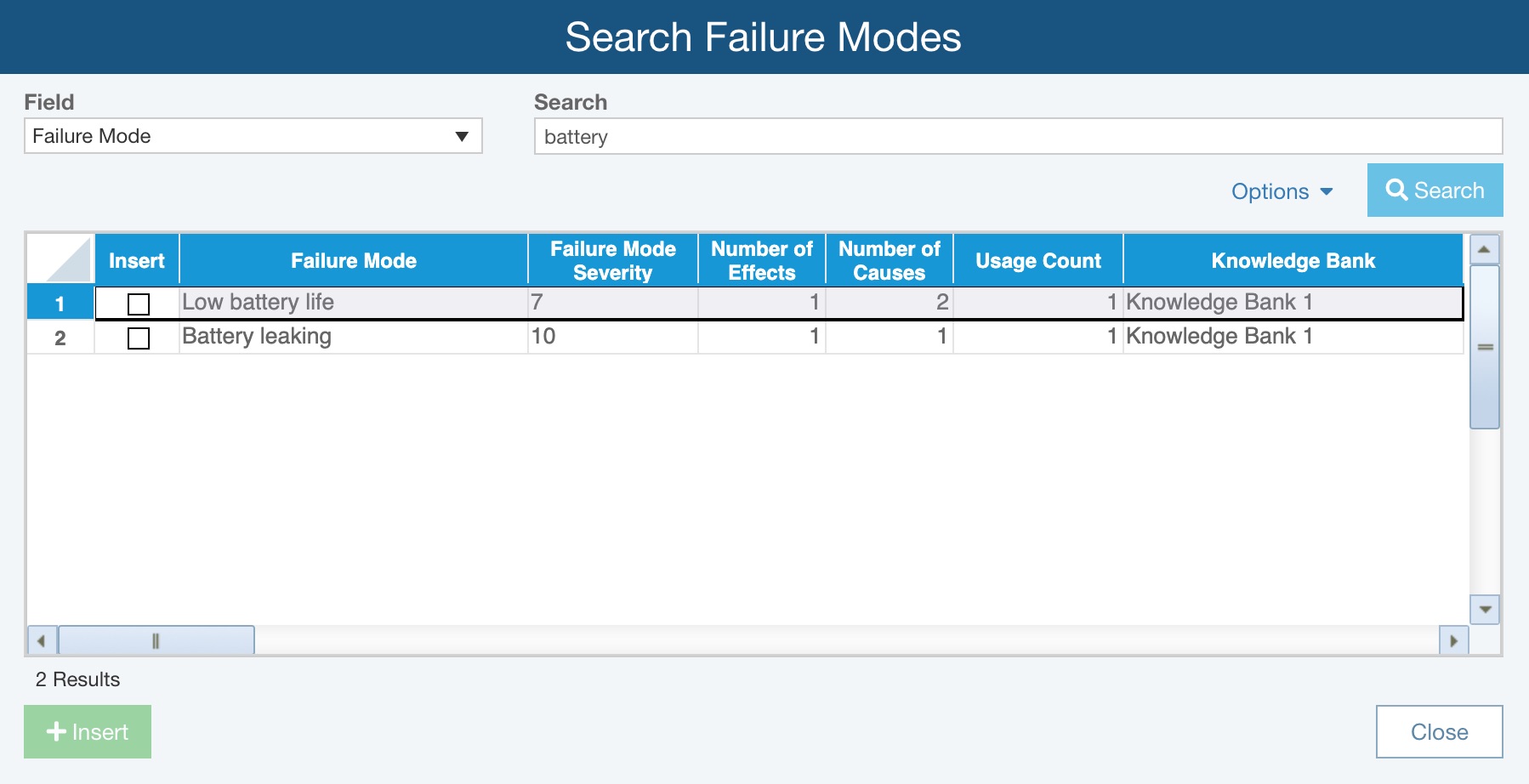
Select the item or items you wish to insert into your FMEA by selecting the Insert checkbox. Click the Insert button to insert the data into your FMEA Worksheet.
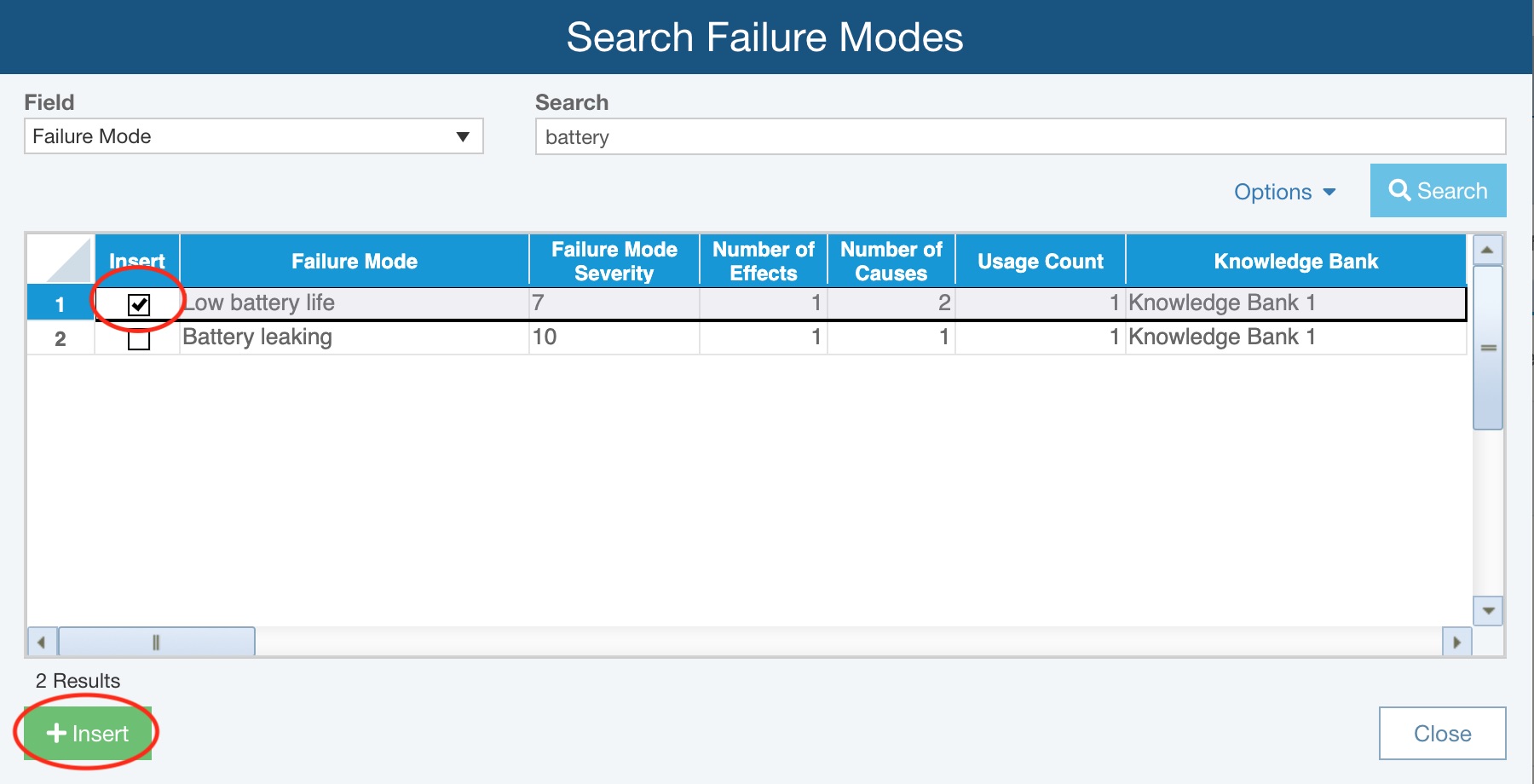
Pushing out Knowledge Bank updates
Another powerful feature of Knowledge Banks is in keeping all your FMEA data tied to Knowledge Banks in sync. For example, you may have a Failure Mode in a Knowledge Bank that is used in multiple FMEAs, and you add a newly discovered Cause to the Failure Mode by either updating or adding to the Knowledge Bank. That change will automatically propagate to all your FMEAs tied to that failure mode through the Knowledge Bank Push feature.
You manage the Push function, so you are in control of how and when the updates are made to your FMEAs. For example, you may want to let your teammates know about a data push prior to initiating. Or, you may want to only push the changes at certain times, perhaps weekly or monthly.
To perform a push, click Knowledge Bank(s) from the Sidebar menu. If only one Knowledge Bank is in use, it will be opened. If more than one Knowledge Bank is in use, select the Knowledge Bank to open from the submenu.
If there are changes in the Knowledge Bank, the Push Changes option from the Bank toolbar button will be enabled. To update the FMEAs tied to this Knowledge Bank, click the Bank>Push Changes.

Note that while Relyence is gathering the list of changes to push, you can click Stop to stop gathering changes to push and return to the Knowledge Bank.
Otherwise, the Push Knowledge Bank Changes dialog appears.
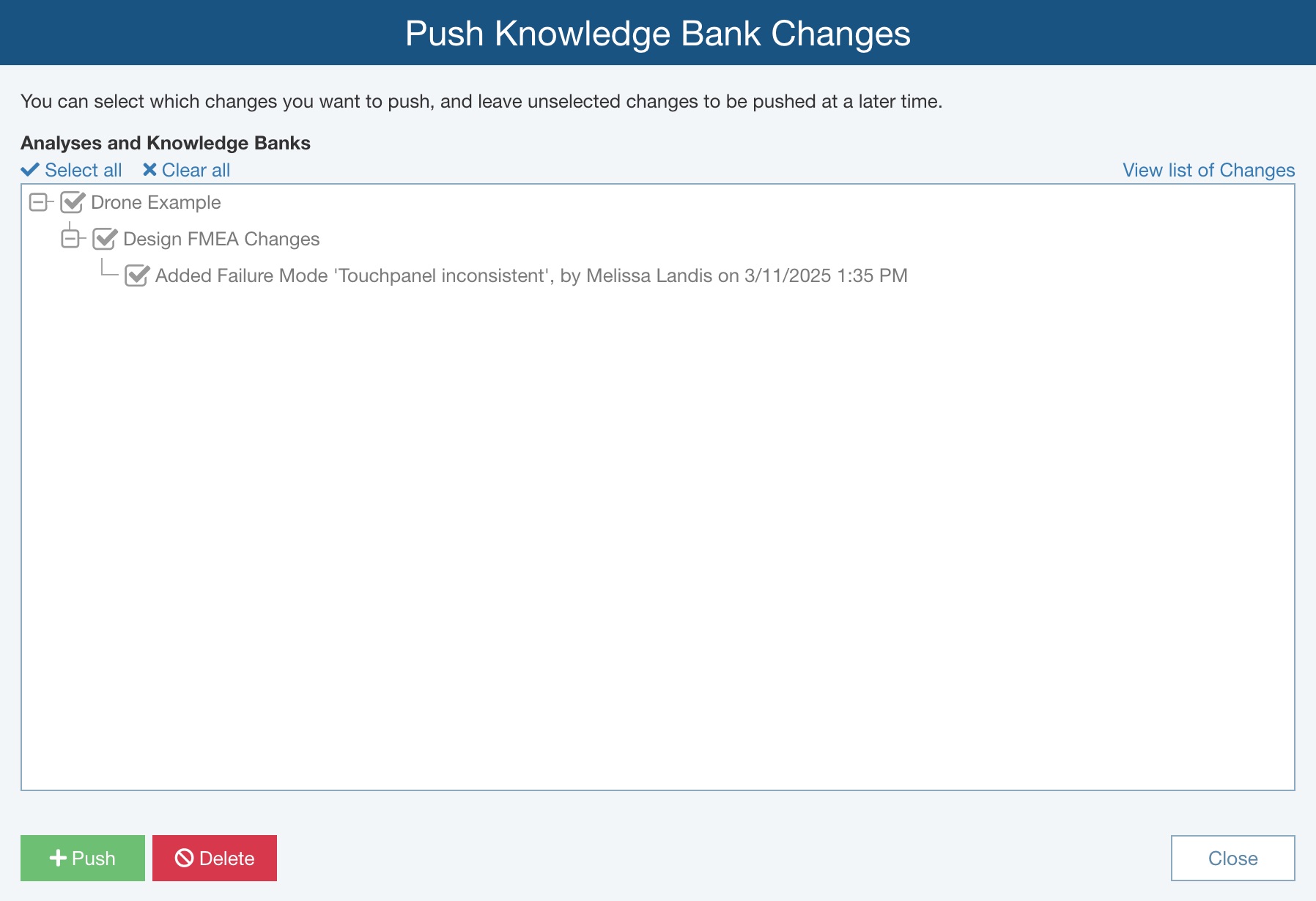
 If any of the Analyses that could be impacted by the Push updates are marked as Read-only in the Analysis Properties and/or have the Do not include in Push updates option checked in the Analysis Properties, the following warning will appear at the bottom of the Push Knowledge Bank Changes dialog:
If any of the Analyses that could be impacted by the Push updates are marked as Read-only in the Analysis Properties and/or have the Do not include in Push updates option checked in the Analysis Properties, the following warning will appear at the bottom of the Push Knowledge Bank Changes dialog:
Note: There are Analyses, Knowledge Banks, or Revisions that are read-only or marked as 'Do not include in Push updates' that cannot be modified by Push Changes.
If needed, modify the Analysis Properties of such Analyses or Knowledge Banks to allow for changes to be made by the Push Changes function.
If there are no changes to be pushed, the dialog will indicate this. In this case, click the Close button to close the dialog.
Otherwise, the dialog will display a list of all the changes that will occur with this Push. The list includes changes within this Knowledge Bank that may need to be pushed to one or more Analyses or one or more Knowledge Banks with data tied to this Knowledge Bank.
The Push Knowledge Bank Changes dialog allows you to choose which changes you want to make with this Push. For example, perhaps you know that a team member is awaiting approval on a section of a certain FMEA, so you want to hold off changes until that review is complete. You can disable that Analysis for this Push. However, note that those changes will still be pending, and will appear the next time you select the Push function.
You can view the list of changes in two ways: by Analysis or by Change. To change the way the Push changes are listed, click the View list of Changes or View list of Analyses link. Click the Expand (+) and Collapse (-) icons in the tree to drill down to see the specific details on the changes to be made.
By default, all changes are selected. Clear the checkboxes next to any changes you want to bypass with this Push.
Use the Select all or Clear all options, where applicable, to enable all checkboxes or clear all check boxes.
To push changes now, select all changes to be pushed and click Push.
- The Push Changes dialog appears and reminds you that the operation is permanent and cannot be undone.
- Click Yes to proceed or No to return to the Push Knowledge Bank Changes dialog.
- When you click Yes, the progress dialog appears and when the push is complete, the Push Knowledge Bank Changes dialog appears and confirms the changes have been pushed out. Click Close.
For any changes you'd like to leave in the list for future consideration, leave their checkmark cleared. Those changes will still be pending and will appear in the list the next time you select the Push function.
To remove changes from the list permanently, select all changes to be removed and click Delete.
- The Delete Changes dialog appears and confirms that deleting the selected changes will remove them permanently from the list of changes to be pushed.
- Click Yes to proceed or No to return to the Push Knowledge Bank Changes dialog.
- When you click Yes, the selected changes are removed from the list and you are returned to the Push Knowledge Bank Changes dialog.
If Knowledge Bank Push Notifications are enabled, a message box appears to allow you to enter in a custom message for this Knowledge Back Push. For example, you may want to include a message indicating what changes were made to the Knowledge Bank and why. You must enter a message in order for the Push to proceed.
Click Back to Analysis in the Sidebar menu to return to your Analysis.
Knowledge Bank Push Notifications
If you want to notify team members when a Knowledge Bank Push occurs, you can enable Knowledge Bank Push Notifications. By default, Push Notifications are disabled.
To enable Push Notifications, make sure the Knowledge Bank is active and select Configure>Workflow>Notifications from the Sidebar menu.

The Edit Knowledge Bank Notification dialog appears.
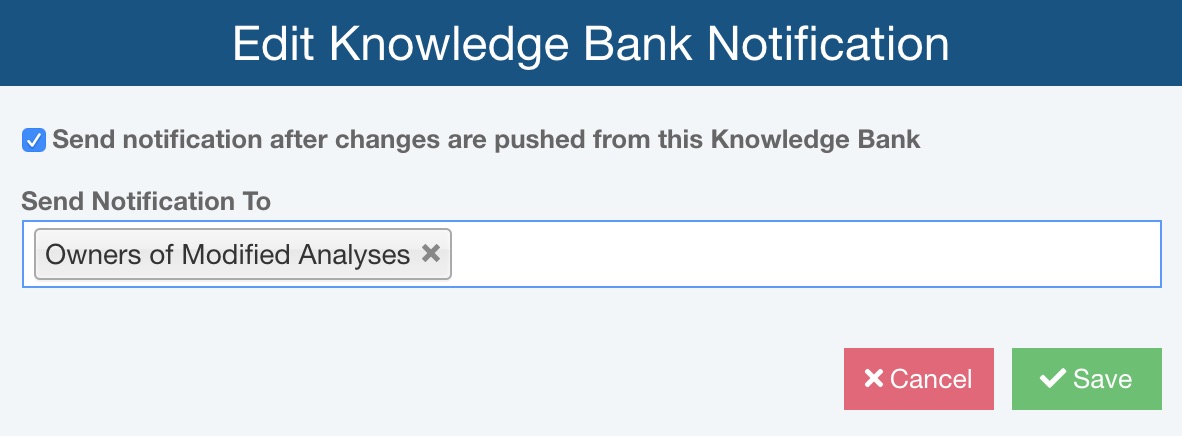
To enable Knowledge Bank Notifications, select the Send notification after changes are pushed from this Knowledge Bank.
You can select from the list of team members to Send Notification To. You can select Owners of Modified Analyses to automatically send notifications to any team members you have designated as Owners on the Analysis Properties settings. You can also add any Users or Groups to include in the notification list.
Click Save to save your changes.
When a Knowledge Bank Push occurs, the team member performing the Push will be required to enter a message to be added to the notification email along with default information included by Relyence.
Once the Push is complete, notifications will be sent to all specified team members. The notification will include the following information:
- The name of the Knowledge Bank
- The name of the team member who performed the Push
- The custom notification message entered by the team member who performed the Push
- The list of Analyses and Revisions that were updated
Viewing data ties to Knowledge Banks
You can view usage of Knowledge Bank data at any time by opening the Knowledge Bank, selecting a data item, and clicking View Usage from the Knowledge Bank toolbar button drop down list.

The Knowledge Bank Usage dialog appears with the list of items by Name, the item Type (Analysis or Knowledge Bank) and associated Subsystem(s) where the FMEA data from this Knowledge Bank is used.

Click Close when finished viewing.
Clearing data ties to Knowledge Banks
By default, when an item is added to a Knowledge Bank, the item in the Analysis is tied to the Knowledge Bank such that if changes are made to the item in the Knowledge Bank and those changes are pushed, the item is updated. You have the option to clear the tie, or linkage, between the item in the Analysis and the item in the Knowledge Bank so that changes in the Knowledge Bank will no longer update the item in the Analysis.
To untie from a Knowledge Bank, select the linked item and from the toolbar, choose Bank>Untie from Knowledge Bank.

The Untie from Knowledge Bank dialog appears.

To complete the process, click Yes. Or, click No if you don't wish to complete the untie.
When the Untie action is completed, the Untie from Knowledge Bank dialog appears stating the item has been untied and indicates the number of records which were updated.

Or, if the item was not tied to the Knowledge Bank, a message appears indicating that no changes were made.

Click Close.
Note that the Untie from Knowledge Bank option will be available from the Bank button even if the specific item is not tied to the Knowledge Bank. If you untie an item that itself is not specifically linked to the Knowledge Bank, the untie function will untie from the Knowledge Bank all items below. For example, if a Function is not tied to the Knowledge Bank, but its Modes are, the untie function selected for the Function can clear all the ties, or linkages, for the Modes and any items below.
Creating Multiple Knowledge Banks
Relyence will create and maintain a single Knowledge Bank for you. You can rename this Knowledge Bank, or create additional Knowledge Banks using the Manage Analyses function which appears in the Account Management dropdown menu in the upper right of the Header Bar.
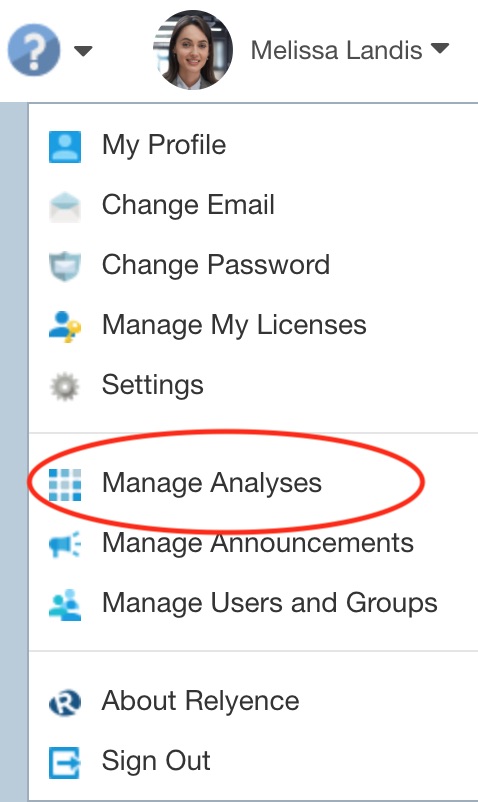
If you are using multiple Knowledge Banks, you can also control which Analyses can access which Knowledge Banks.
For more details, see the Using the Manage Analyses Function topic of this guide.
Enabling Knowledge Bank Audit Trails
You can enable audit trail logging for your Knowledge Banks if you want to track all data changes. See the FMEA Audit Trail topic for more information on this feature.
Pulling Changes into Knowledge Banks
Another powerful feature of Knowledge Banks is in keeping your Knowledge Banks up-to-date with additions or changes made in Analyses or Knowledge Banks as FMEA work is completed.
For example, you may have a GPS Subsystem and all its FMEA data stored in a Knowledge Bank and then you create an instance of the GPS that is tied to the Knowledge Bank. During a FMEA review, it is determined that an additional Failure Mode should be considered. That additional Failure Mode is added to the GPS Subsystem in the Analysis, which is tied to the Knowledge Bank. In some cases, it might be useful to add that Failure Mode to the Knowledge Bank and then Push those changes. In order to add that additional FMEA data to the Knowledge Bank, you can use Pull Changes feature.
In our example, the GPS in the Knowledge Bank looks like this:
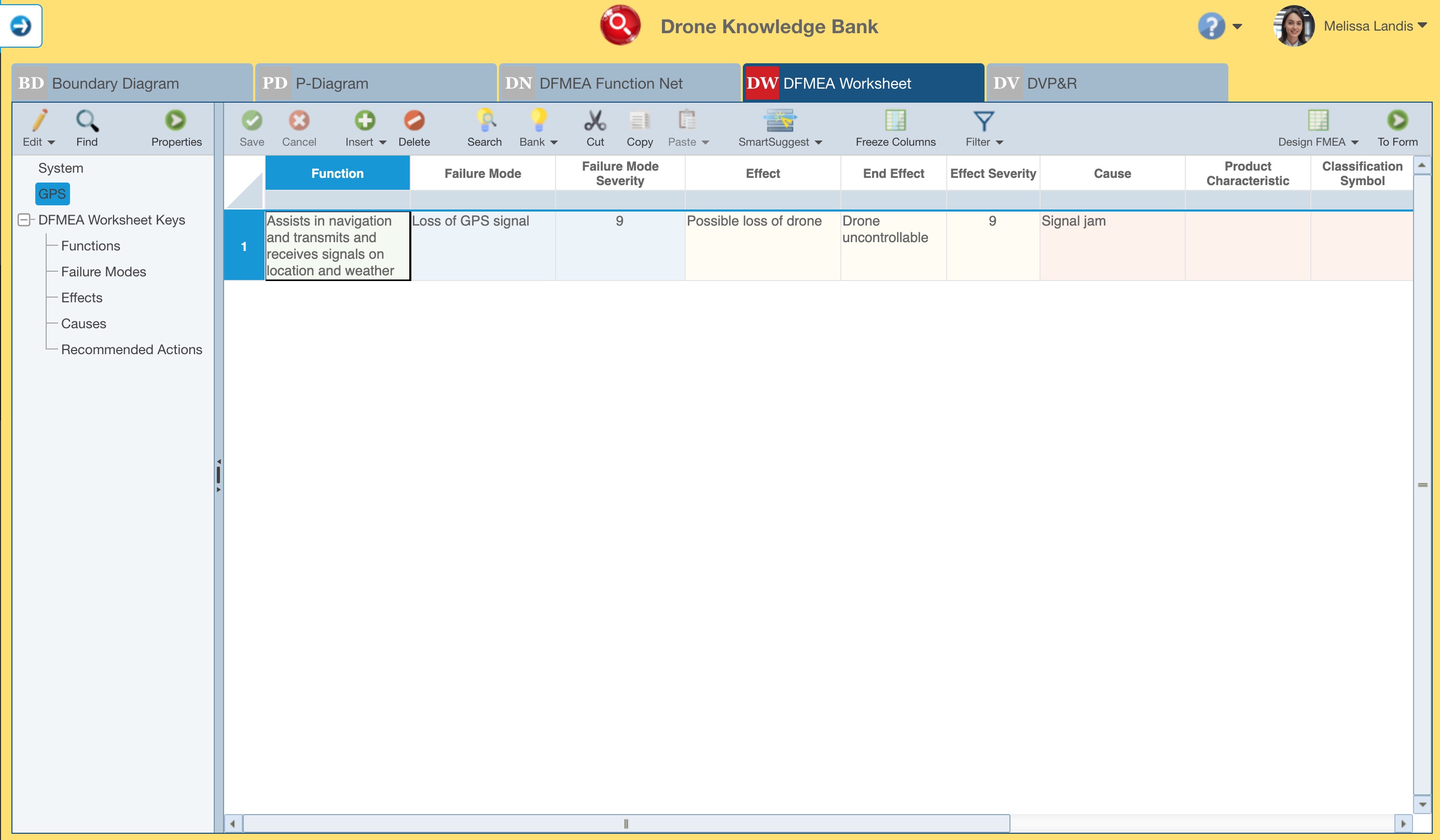
And, in our in-progress Analysis, we determine we must add another Failure Mode. So, the GPS gets updated to include the additional Failure Mode data and looks like this:

To pull those changes into the Knowledge Bank for future use, you can open the Knowledge Bank and from the toolbar, select Bank and then Pull Changes.

Note that while Relyence is gathering the list of changes to pull, you can click Stop to stop gathering changes to pull and return to the Knowledge Bank.
Otherwise, the Pull Knowledge Bank Changes dialog appears.
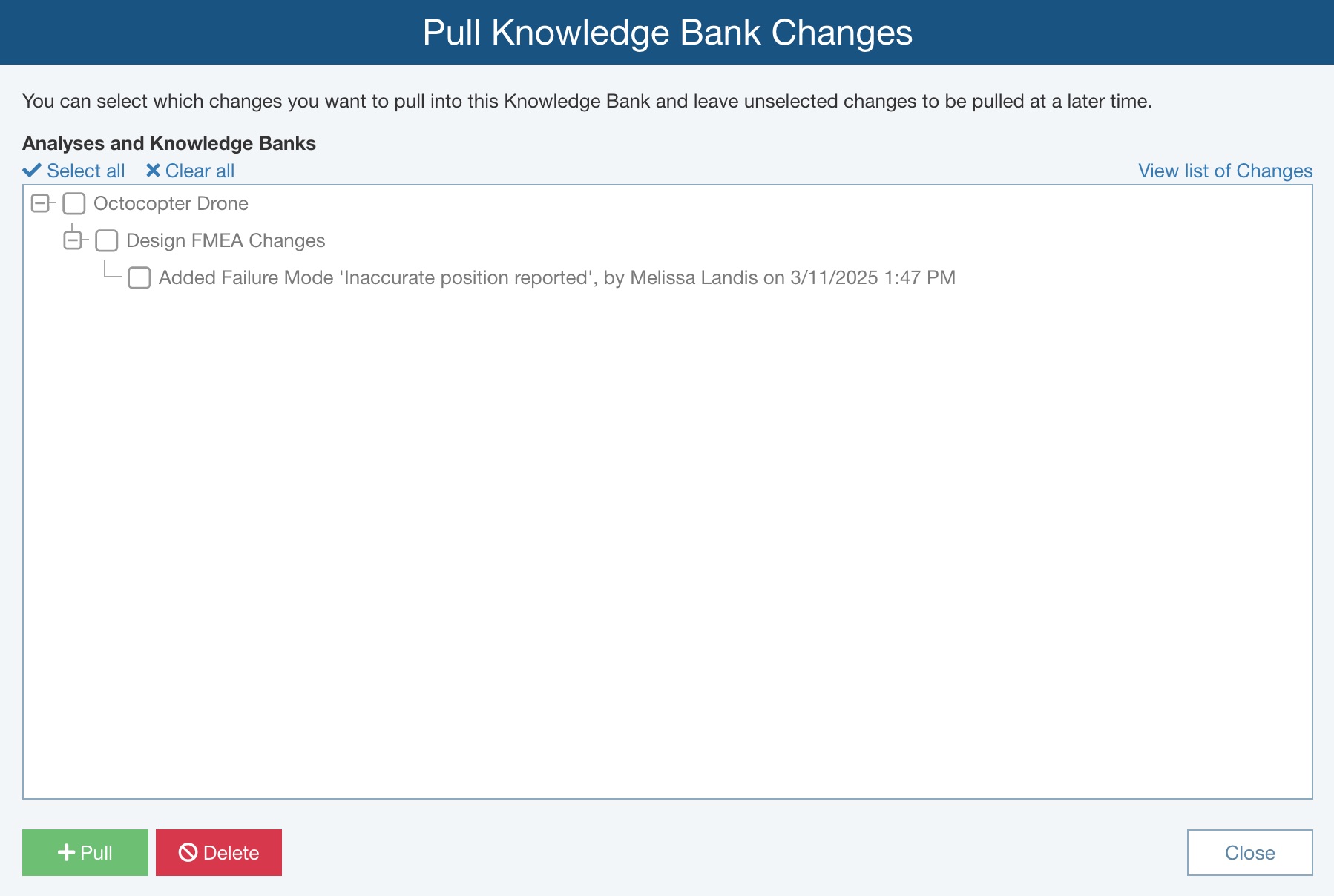
This dialog displays changes made in Analyses and associated Knowledge Banks that have data tied to this Knowledge Bank.
You can view the list of changes in two ways: by Analysis or by Change. To change the way the Push changes are listed, click the View list of Changes or View list of Analyses and Knowledge Banks link. Click the Expand (+) and Collapse (-) icons in the tree to drill down to see the specific details on the changes to be made.
You can click to select any changes that you do not want to Pull into the Knowledge Bank and then click Delete to remove them from the list permanently.
Click to select any changes that you want to Pull into this Knowledge Bank by selecting the checkmark and then click Pull to add them.
If there are any changes you want to leave in the list for consideration in a future Pull, leave their checkmark cleared; those changes will still be pending, and will appear the next time you select the Pull function.
To select all changes to ignore or pull, click Select all. To deselect all changes to ignore or pull, click Clear all.
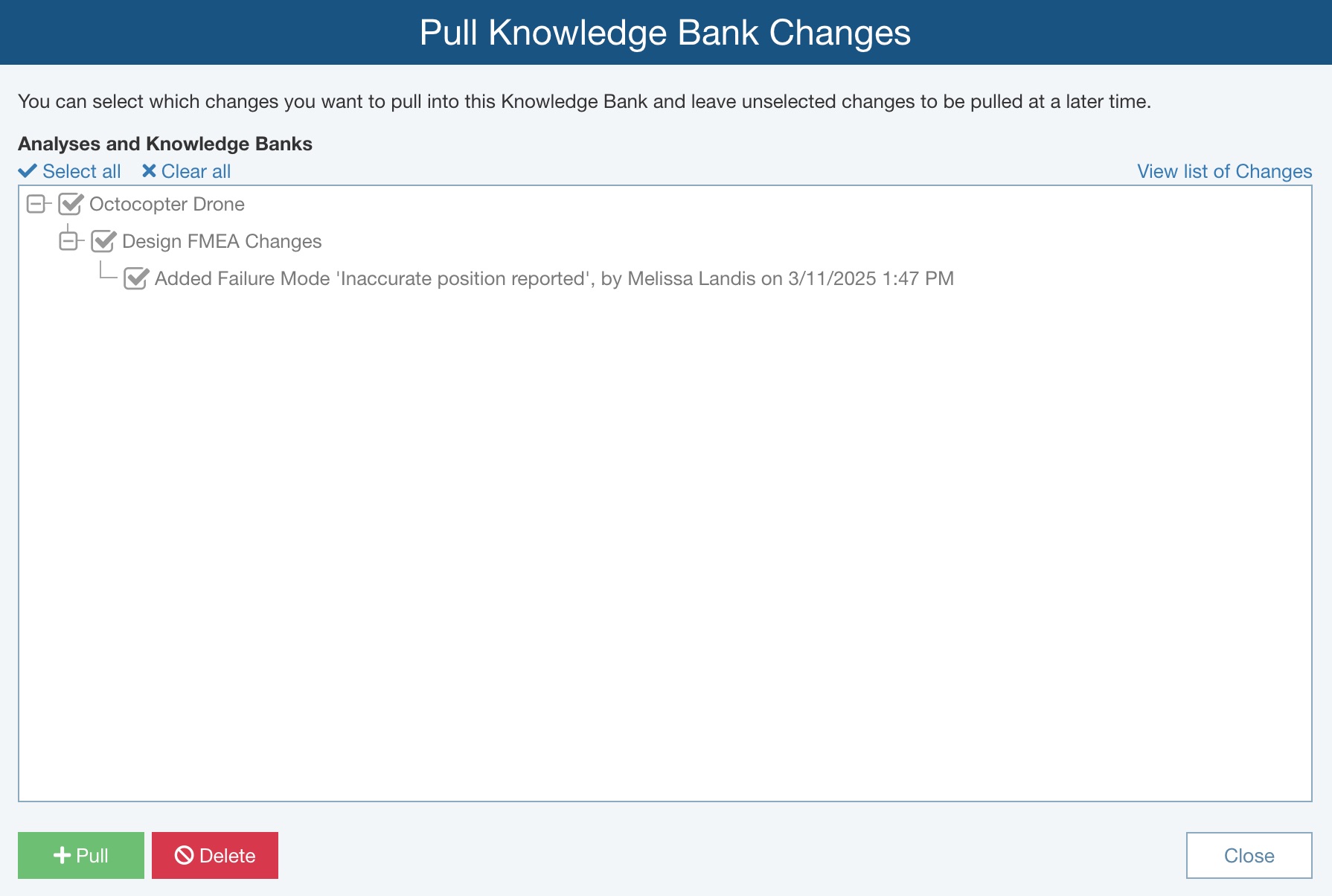
The Pull Changes dialog appears with a warning that the operation is permanent and cannot be undone.

If you are confident to make these changes at this time, click Yes; otherwise click No.
A green message appears in the bottom right of the screen to confirm the Pull changes is completed. The Pull Knowledge Bank Changes dialog appears with any outstanding changes to consider for pulling or a message confirming that there are no changes to be pulled into the Knowledge Bank at this time. Click Close.
In the example Knowledge Bank, the GPS Subsystem was updated to include the additional Failure Mode and related data.

If that GPS is used in other places, you can optionally use the Knowledge Bank Push function to update other instances of the GPS. See the earlier section, Pushing out Knowledge Bank updates, for more details about how to Push updates from the Knowledge Bank.
You manage the Pull function, so you are in control of how and when the updates are made to your Knowledge Banks. For example, you may want to let your teammates know about a data Pulls prior to initiating or after completion so they may consider an update via the Push function. Or, you may want to only pull the changes at certain times, perhaps weekly or monthly.
If there are no changes to be pulled, the dialog will indicate this. In this case, click the Close button to close the dialog.
All updates to your Knowledge Bank data will automatically be made.
Once the Pull is complete, the Pull Knowledge Bank Changes dialog appears with the list of remaining changes to pull at a future time or a message indicating there is no data to pull.
At any time, you can select potential changes and click Delete to remove those items from the list.
When you have completed reviewing, click Close to close the dialog.
Click Back to Analysis in the Sidebar menu to return to your Analysis.
Creating and Using Custom FMEA Formulas in Knowledge Banks
You can create and use custom FMEA Formulas in Knowledge Banks. You can find more details in Creating Your Own FMEA Formulas.
To create custom FMEA Formulas in a Knowledge Bank, from the Sidebar, select Configure>Formulas.
To perform the calculations defined in your custom FMEA Formulas in a Knowledge Bank, from the Sidebar, select Perform>Formula Calculations.